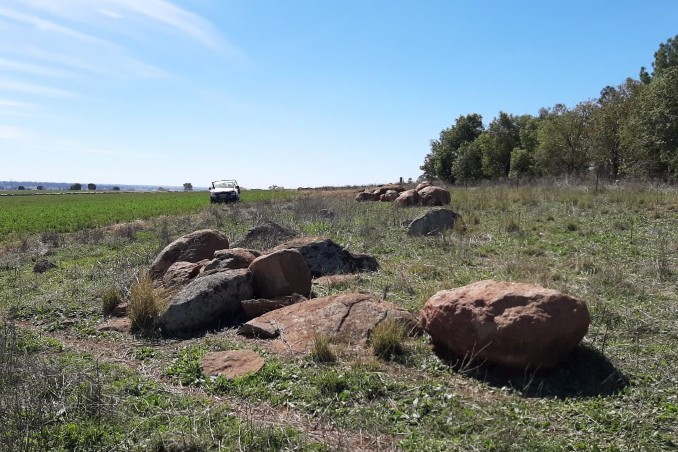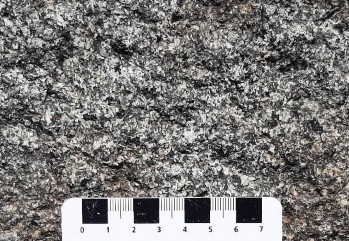
Authors: Mike Smith, Director, National Rock Garden & Lance Black, Retired Geochronologist
Extract from National Rock Garden Newsletter No. 21, June 2021
A large financial contribution to the National Rock Garden is enabling the delivery of a large boulder of Middledale Gabbroic Diorite to the ACT later this year. The donors have watched the steady progress of the NRG Steering Committee over recent years, have attended a rock launch, and brought their grandchildren to the present display.
The first step, entailing the selection of an appropriate specimen, was completed in the second week of April this year. The authors visited the property near Temora which was identified in 1998 by Geoscience Australia (GA) as hosting a reliable rock source of isotopically undisturbed zircon crystals which are very important for geological research work.
The aim of this recent field trip was to meet with the property owners who had previously agreed to donate a large boulder from their land to the National Rock Garden. Our task was to measure the physical dimensions of a range of diorite boulders and to calculate their probable weight using the density of 2.79 gm/cc provided by GA staff for this rock. Numerous large boulders had been uplifted from the farm paddocks and pushed to the edges of the fields, making our job relatively easy.

The selected NRG specimen is shown below, and has an estimated weight of the order of 7-8 tonnes. Once a smooth face has been polished, its crystal texture will be an attractive feature.

The Middledale Gabbroic Diorite has been proven to be a source of zircon crystals that permit reliable U-Pb isotopic dating. Now known as geochronology standard TEMORA-2, the zircons have become an extremely important world-wide reference material for geological dating (read more on GA’s website).
These zircons have been impervious to chemical interaction since the crystallisation of their host diorite 417 million years ago. In particular, the proportion of radioactive isotopes and daughter products is identical for all of the zircons, allowing the age measured for each crystal to be compared directly with the measured age of crystals whose age is not known.
One particular type of instrument that can undertakes these age comparisons is known as the SHRIMP, short for Sensitive High Resolution Ion Microprobe, designed, and built at the Australian National University for several decades. One of these instruments was installed at GA at the end of 2007. You can read a full description of the operation of the GA SHRIMP, and about the many complex geoscience issues that may be resolved by the use of the SHRIMP facility in AusGeo News and on the GA website.

The donation of funding for the uplift, transport and preparation of this large rock for display is another positive step in the development of the National Rock Garden in Canberra. The diorite is important from the perspective of the scientific use of rocks, in contrast to the more general use of rocks for large scale construction of buildings, for monuments and in sculpture.


